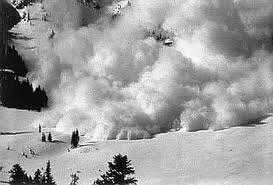What is an avalanche? , well it’s a large mass of snow and ice or of earth or rock sliding down a mountain side or a cliff. And how does an avalanche occur, well mainly they happen by vibrations caused by movement of the earth such as an earthquake, gunfire, rainy weather, and many more. Think about past avalanches and landslides that have occurred like the 1903 Frank landslide and avalanche that happened at the same time, in Alberta Canada it destroyed the parks canyons it’s beautiful trees’ it’s wonderful sights and killed nearly one hundred people, and covered a small town near Alberta with ice and snow.
Another devastating avalanche incident is the 1964 Sherman slide, in which a huge avalanche was triggered by the 1964 Alaskan earthquake.  The slide spilled out onto the Sherman glacier, during the big slide several other smaller slides happened and those were the one that took lives in Anchorage, and destroyed property There are a couple of types of avalanches and how they destroy so much this one is named “Loose Snow Avalanches”1, it starts’ in a small area then grows in size and mass as it descends. Another type is the “Slab Avalanche” it actually starts in a large area of ice and snow and then begins to slide.
The slide spilled out onto the Sherman glacier, during the big slide several other smaller slides happened and those were the one that took lives in Anchorage, and destroyed property There are a couple of types of avalanches and how they destroy so much this one is named “Loose Snow Avalanches”1, it starts’ in a small area then grows in size and mass as it descends. Another type is the “Slab Avalanche” it actually starts in a large area of ice and snow and then begins to slide.
On September 12 of 1717 crusaded down the Troilet, Italy glacier, gaining speed on a cushion of air reaching a falling velocity of km/hr over a 3600 m fall. Two towns were destroyed, with seven people killed and a 120 cows lost. The slosh of an avalanche ran up the far side of the valley at a speed of 125 km/hr. In developed areas such as ski resorts it is possible to predict avalanches because they are controlled with explosives and artillery. In a back-country areas it is possible to predict avalanches because the forecast relies on experience of the person making the observation. There are no computer models available to predict avalanches and therefore predictions are only accomplished by repetitive observations and knowledge of snow properties.
Due to difficulty in reliable predictions method areas of avalanche hazards must rely on controlling or altering the effects of an avalanche.
The back country explorer must be highly skilled in determining safe routes and rescue procedures over and above relying on predictions of avalanches for personal safety. Avalanches kill people many ways but the most common cause of death is suffocation. There is little air trapped in the avalanche and within a short period of time the victim loses consciousness and dies. A victim can also be killed from the force of the snow slamming into the body or by traveling in the avalanches and being smashed against trees and other objects.
Knowledge can help you avoid being caught by a snow avalanche; it may help you survive if you are buried. Snow avalanches are natural phenomena so complex one can never have all the information necessary to predict avalanche conditions with certainty.
Bibliography
Mears,Ronald I., Design Criteria for Avalanche Control Structures in the Runout Zone, June1981.
S.D., All You Ever Wanted To Know About Snow…, November 24, 1988.
Snow Avalanches from Cold Regions Hydrology and Hydraulics, Ryan, W.L.
Snow Avalanche Hazards and Mitigation in the U.S.
